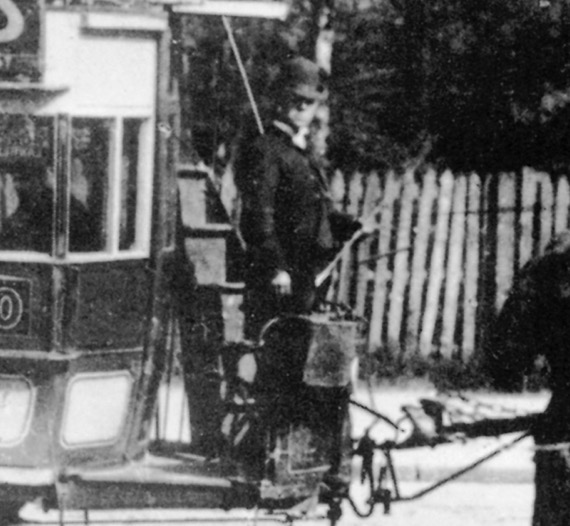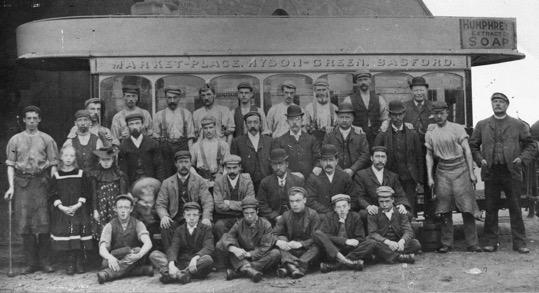Nottingham and District Tramways
History
Nottingham's standard-gauge, horse-drawn tramway, which was owned and operated by the Nottingham and District Tramways Company, officially opened on the 17th September 1878, commencing public services the following day.
The company, which was established in 1875 following several failed attempts to build a tramway by the Nottingham Tramways Company, had more luck than its predecessor, successfully obtaining powers on the 23rd July 1877 under the Nottingham and District Tramways Order, which was passed into law under the umbrella of the Tramways Orders Confirmation Act, 1877.
The system was opened in three stages, and was completed on the 5th June 1881 with the opening of a line to Basford. Although the company made several attempts to extend the system, these ran into municipal objections, so never came to fruition. At its maximum, the tramway comprised 7.5 route miles, but in two unconnected halves, each having a depot and being operated independently; it is unclear why the two were never joined, though it was more than likely due to opposition from the council.
The southern half of the system comprised a line running southwards from St Peter's Church near the Market Place to Trent Bridge, the terminus being at the bridge itself, with an additional line running eastwards along Station Street and London Road, which served what were at the time, the town's two main railway stations (belonging to the Midland Railway Company and the Great Northern Railway Company). The terminus for the northern half of the system was in the Market Place, the main line running westwards to the end of Long Row, where it divided, the Basford line continuing along Chapel Bar, then turning northwestwards via Derby Road, Alfreton Road and Radford Road to a terminus at Church Street (Basford); the Carrington line heading northwards from Long Row along Market Street, Parliament Street and Mansfield Road to a terminus outside St John's Church (Carrington). The Basford and Carrington lines were also connected via a line along Forest Road, which had many prosperous inhabitants, making the route along it the company's most profitable.
The tramway was an immediate financial success, with large numbers of passengers being carried. Trouble, however, lay ahead, as the entire system had been laid with rails patented by Winby and Levick, which though representing a significant technological advancement, ultimately proved to be problematical, particularly when laid on an insecure foundation, as was the case in Nottingham, loosening of the rails eventually occurring. Unlike many horse and steam tramway companies, the N&DTCo spent time and money rectifying the problems — though it occasionally had to be prompted by the council — and seems in general to have ensured that the tramway infrastructure was well maintained, buying new vehicles throughout its 20-year life.
The company hosted a Hughes steam tram engine in 1880, possibly in response to a request from the manufacturers, who were relatively local (Loughborough), though nothing came of it. One reason for the company's interest was almost certainly the Basford line, which had a very steep section in Derby Road (1 in 13) that required the use of two trace horses to get a two-horse tramcar up it, the expense of which no doubt turned the company's thoughts to the possibilities of what was hoped would be a cheaper form of traction.
Steam tram technology was still in its developmental stage in the early 1880s, so the company was perhaps unconvinced about what it saw; however, in late 1881 it decided to try again, this time with a Wilkinson engine. Unfortunately, it took over 12 months from seeking the permission of the council to the engine entering service; the engine and trailer, which were probably initially on hire from the manufacturers were late in arriving, and to add to the company's woes, the Board of Trade then asked for various alterations to the track before it would issue a licence for steam operation, the latter under powers granted to it on the 11th August 1879 by the Tramways Order Confirmation Act, 1879.
The licence only covered the use of steam on the Basford line, and was initially subject to annual renewal, the first services probably commencing in November 1882 (accurate records are lacking). Unfortunately for the company, the first renewal brought forth a number of complaints from the owners of properties in the Market Place and Chapel Bar concerning the public nuisance caused by the engine (noise, smoke and smell), the end result of which was that the service was cut back to Tollhouse Hill. It is unclear whether this was at the behest of the Board of Trade or an attempt by the company to placate the objectors.
The engine is believed to have last run in regular service in 1889, after which the licence was not renewed, possibly due to deterioration of the track, which was susceptible to movement, so could hardly have fared well under daily punishment from a heavy steam engine and a large bogie trailer. It is unclear why the company did not buy more engines, as attempting to run and maintain a single engine, with no spare, can hardly have made for efficient operation, especially when run inbetween slower horse cars.
By 1890, the traders' associations and other influential bodies were complaining about the lack of modern transport facilities, particularly in areas that were not served by the tramway. There was, however, little that the corporation could do given that it could not forcibly purchase the undertaking until 1898, when it would be entitled to do so under the '21-year rule' of the Tramways Act of 1870. However, by 1895, with the 1898 date drawing ever nearer, the corporation set up a committee — on the 6th December — to look into its options moving forward, including what type of system was needed, what districts it should serve, and also, whether the corporation should own and operate it. Nine months later, on the 7th September 1896, the committee recommended that parliamentary powers be acquired to build and operate an electric tramway system, and also, that the corporation should acquire the horse tramway .
Following negotiation with the company, the corporation purchased the undertaking on the 14th June 1897, the company continuing to operate it until the corporation was legally able to take over, this being on the 18th October 1897, the Nottingham Improvements Act 1897 having been passed into law on the 6th August 1897. At the time, the corporation did not have advanced plans for a new tramway system, and it was clear that it would take some considerable time to agree these, let alone acquire powers and construct the system, so it duly set about improving the horse tramway, including the frequency of the services and the condition of the track and vehicles, as well as staff conditions.
The corporation obtained powers to convert the horse tramway to electric traction and extend the system on the 13th July 1899 under the Nottingham Corporation Act, 1899, subsequently deciding to use overhead current collection. The first electric services commenced on the 1st January 1901, with the last horse service being withdrawn on the 30th April 1902, the corporation having operated the horse trams for just over four-and-a-half years.
Uniforms
The Nottingham and District Tramways Company operated horse trams for just over 19 years before being taken over by Nottingham Corporation. The surviving photographic record is relatively rich, and clearly shows that horsecar drivers wore robust but informal attire (jackets, overcoats, etc.) along with the ubiquitous bowler hat. The situation with conductors is less clear, though in all probability they also wore smart but informal attire, along with peaked or flat caps. No badges or licences of any kind were worn.
The N&DTCo also operated a steam tram (between 1882 and 1889). A single photograph has survived which shows fitters and crewmen with this engine; drivers wore typical railway footplate-like attire (e.g., cotton trousers, jackets and caps), whilst conductors wore informal attire and bowler hats.
Further reading
For a history of Nottingham's horse trams see: 'A History of Nottingham City Transport, 1897-1959' by Roy Marshall; Nottingham City Transport (1960).
Images
Horse tram drivers and conductors
A superb shot of one of four trams (Nos 31 to 34) which had been converted from horse omnibuses acquired by the N&DTCo in 1888 (from Andrews of Carrington) — photo undated, but probably taken in the late 1880s or early 1890s. Photo courtesy of the Tramways and Light Railway Society, with thanks to David Voice.
An enlargement of the above photograph showing the driver, who is clearly wearing informal attire and a bowler hat.
The situation with the conductor is less clear, though he would appear to be wearing informal attire.
N&DTCo staff assembled at what is probably the depot on Isandula Road near Basford, with a Starbuck-built horsecar behind them — photo undated, but probably taken in the late 1880s or early 1890s. Photograph courtesy of the National Tramway Museum.
An enlargement of the above photograph showing some of the smarter-dressed individuals, who are more than likely drivers and conductors.
Another shot of a converted horse omnibus, this time readily identifiable as No 31, turning out of Long Row and into Market Street around 1890. Once again, the driver is in informal attire with a bowler hat. Author's Collection.
An unidentified N&DTCo horsecar — photo undated, but probably taken in the 1890s. Photo courtesy of the Tramways and Light Railway Society, with thanks to David Voice.
Steam tram drivers and conductors
A very poor quality photograph, but the only one known to have survived that shows the crew of the N&DTCo's only steam tram, a Wilkinson engine. It is pictured with a large, double-deck trailer, No 29, which means that the photo must have been taken between 1884 and 1889. It was obviously an occasion of some sort as there are three men on the engine. The conductor, with cash bag, is standing on the platform of No 29; he appears to be wearing informal attire and a bowler hat.